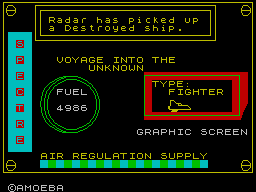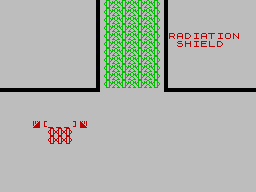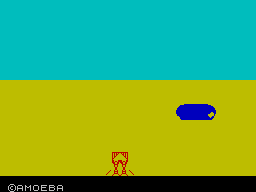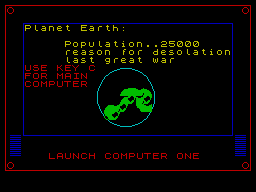Retro Replay Review
Gameplay
Voyage into the Unknown greets players with an immediate sense of trial-and-error frustration. With no manual or in-game tutorial, you’ll spend your first ten minutes just trying to figure out how to power up your ship. The fact that you must guess commands like “E” for Engine, “P” for Power, and “I” for Ignition only underscores how little guidance the game provides. This free-form approach might appeal to puzzle enthusiasts, but it feels more like flailing in the dark than uncovering hidden mechanics.
Once you finally blast off, the gameplay loop consists of navigating through a series of static screens where every interaction is another guessing game. Should you press “T” to activate a Time Warp Chuck Out, or “B” to deal with a mysterious Buke? There’s no pattern or logic disclosed, so each new encounter becomes a random gamble. For players accustomed to the tight, responsive controls of other Spectrum titles, this lack of clarity and polish can be genuinely off-putting.
Combat, if it can be called that, is purely symbolic. There are no animations, no audio cues, and no feedback beyond shifting to another pre-drawn screen. You might press a key, wait several seconds as the Spectrum Basic engine sluggishly renders the next frame, and then… hope for the best. The result is a stop-start rhythm that tests your patience more than your strategic thinking.
In theory, forcing players to learn by repeated experimentation could yield a satisfying sense of mastery—if the controls were consistent and the responses timely. In practice, Voyage into the Unknown rarely rewards perseverance. You’re more likely to abandon the quest for the all-powerful Crystal after a single frustrating session than to feel motivated to press on.
Graphics
Graphically, Voyage into the Unknown is a textbook case of what happens when you opt for Spectrum Basic over optimized machine code. Each screen draws blocky, monochrome shapes at a glacial pace, often leaving you staring at a half-finished image as you wait for the computer to catch up. If you’re in love with bold, flicker-free sprites or smooth scrolling backgrounds, you’ll be disappointed.
There’s an unmistakable charm in seeing simple lines form your starship and creepy alien forms pixel by pixel, but the novelty wears off fast. Key mapping and animation frames are so sparse that most screens look like static text art more than dynamic game environments. In a library that includes classics boasting vibrant color clashes and fluid motion, this title feels like a relic—even by Spectrum standards.
Even the Maze of Total Blackness, which promises a tense, shadowy challenge, ends up being two-tone graphics with just enough contrast to avoid accidentally walking through a wall. The near-absence of detail means you’ll frequently misinterpret solid walls for empty space, leading to more guesswork and frustration. It’s tough to build immersion when you can’t easily distinguish between obstacles and open passages.
Ultimately, if you’re drawn to retro visuals, you might appreciate the primitive aesthetic as an artifact of early home computing. But if you expect coherent level design, clear visual feedback, or any kind of graphical flourish, this game falls well short of modern nostalgic benchmarks.
Story
The game’s backstory reads like a mash-up of post-apocalyptic sci-fi clichés: you’re one of Earth’s survivors after a Great War, stumbling upon a lone spaceship just as the ominous Death Star forces prepare their final assault. Inlay copy promises a quest for an “all-powerful Crystal,” a treacherous maze, and a climactic showdown. On paper, it sounds intriguing enough to spark your curiosity.
Regrettably, almost none of this narrative richness translates into gameplay. There are no cutscenes, no character portraits, and no dialogue beyond terse status messages. You’ll know you’ve reached the Death Star only because the label “Death Star” appears at the top of the screen. There’s no sense of rising tension, no voiceover, and certainly no world-building that might justify your heroic mission.
The sparse storytelling leaves you filling in huge gaps with your imagination. If you enjoy crafting your own lore or picturing elaborate sci-fi epics in your head, you might find this bare-bones presentation oddly freeing. But for players who crave a delivered narrative arc, character development, or cinematic flair, Voyage into the Unknown proves frustratingly thin.
In the end, the game’s premise is more interesting than its execution. While many contemporary titles on the Spectrum leveraged striking visuals and compelling dialogue to draw you into their worlds, here you’re left with a basic outline and no script. It’s hard to feel invested in destroying the Death Star when there’s almost nothing connecting you to the stakes at hand.
Overall Experience
Voyage into the Unknown serves as a fascinating time capsule of how not to develop a Spectrum game in BASIC—but that’s about its only redeeming quality. Without audio, polished visuals, or clear instructions, it struggles to stand alongside better-executed titles of its era. The core experience revolves around frustration: bit-by-bit graphic draws, guess-the-control gameplay, and a narrative that rarely materializes onscreen.
It may hold some appeal for Spectrum collectors who enjoy sifting through obscure releases or museum-style retrospectives. There’s a nostalgic charm in confronting the limitations of early home computing, especially if you grew up memorizing key layouts just to play simple B-rated arcade clones. But for anyone seeking an engaging, coherent adventure, Voyage into the Unknown falls woefully short.
If you’re on a budget and curious about Spectrum history, this title might be worth a quick look—especially if you already own a vast library of higher-quality games and want to explore the outliers. However, if you’re shopping for your first spectrum purchase or hunting for a genuinely fun retro gaming session, you’d be better served by classics like Jetpac, Spectral Invaders, or Elite.
In summary, Voyage into the Unknown remains an odd footnote in Spectrum’s storied past. Its ambition to deliver a sprawling space adventure is admirable, but its technical execution and user experience make it difficult to recommend without heavy caveats. Approach with tempered expectations, and only if you’re ready to embrace cryptic controls and glacial load times as part of the nostalgia package.
 Retro Replay Retro Replay gaming reviews, news, emulation, geek stuff and more!
Retro Replay Retro Replay gaming reviews, news, emulation, geek stuff and more!









Reviews
There are no reviews yet.